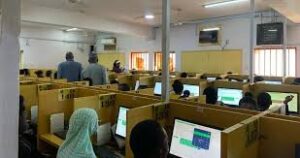In a dramatic turn of events at the Joint Admissions and Matriculation Board (JAMB) policy meeting in Abuja, Nigeria’s Minister of Education, Tahir Mamman, reversed his initial directive on the minimum age for university admission. This decision, which maintains the status quo of allowing 16-year-olds to enter tertiary institutions, came after significant pushback from educational stakeholders and highlights the complexities of implementing education policies in Nigeria.

The meeting, attended by key figures in Nigeria’s higher education sector including university vice-chancellors, polytechnic rectors, and college provosts, was initially rocked by the Minister’s announcement that only candidates aged 18 and above should be admitted. This proposed change was based on the Minister’s interpretation of existing education laws and policies, which outline a typical educational journey starting at age six and lasting 12 years before tertiary education.
However, the immediate reaction from the audience, consisting mainly of heads of tertiary institutions, was one of concern and disagreement. Their objections stemmed from practical considerations, including the fact that many candidates under 18 had already taken the Unified Tertiary Matriculation Examination (UTME) without anticipating such a change.
The swift reversal of the policy highlights several important aspects of Nigeria’s education landscape:
1. The disconnect between policy formulation and on-the-ground realities: The initial directive seemed to overlook the current practices and the readiness of many younger students for higher education.
2. The power of stakeholder engagement: The voices of educational institutions played a crucial role in shaping policy, demonstrating the importance of inclusive decision-making in education.
3. The flexibility (or inconsistency) in policy implementation: The quick turnaround on the decision raises questions about the process of policy formation and implementation in Nigeria’s education sector.
4. The ongoing debate about the appropriate age for university education: This incident has reignited discussions about student maturity, academic readiness, and the structure of Nigeria’s education system.
The controversy also sheds light on the broader challenges facing Nigeria’s education sector. With a rapidly growing youth population and limited spots in tertiary institutions, the country grapples with issues of access, quality, and relevance in higher education. The age of admission is just one aspect of a complex set of challenges that include infrastructure deficits, funding issues, and the need to align education with economic opportunities.
Moreover, this incident underscores the delicate balance between maintaining educational standards and ensuring inclusivity. While the intention behind the initial 18-year age limit might have been to ensure student maturity and readiness for higher education, it could have potentially excluded talented younger students and disrupted the educational plans of many families.
As Nigeria continues to navigate these educational challenges, this episode serves as a reminder of the need for thorough consultation and consideration of diverse perspectives before implementing significant policy changes. It also highlights the dynamic nature of education policy-making in a country striving to improve its educational outcomes while dealing with demographic and economic pressures.
Moving forward, stakeholders in Nigeria’s education sector will likely call for more transparent and inclusive processes in policy formulation. The incident may also prompt a more comprehensive review of admission policies, taking into account not just age but also academic readiness, socio-economic factors, and the overall goals of higher education in national development.
As the dust settles on this policy reversal, the focus now shifts to how Nigeria can enhance the quality and accessibility of its higher education system while ensuring that policies are both practical and aligned with the country’s educational objectives.




